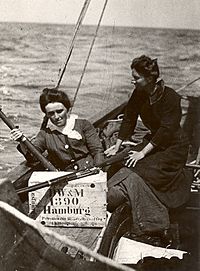Molly Childers facts for kids
Quick facts for kids
Molly Childers
|
|
|---|---|
 |
|
| Born |
Mary Alden Osgood
14 December 1875 Boston, Massachusetts, U.S.
|
| Died | 1 January 1964 (aged 88) Sandymount, Dublin, Ireland
|
| Resting place | Roundwood, County Wicklow, Ireland |
| Nationality |
|
| Alma mater | University of Nottingham |
| Spouse(s) | |
| Children | 3, including Erskine Hamilton Childers |
| Parent(s) |
|
| Relatives |
|
Mary Alden Childers (born Osgood; 14 December 1875 – 1 January 1964), known as Molly Childers, was an American-born Irish writer. She was also a strong supporter of Irish independence, known as an nationalist. Her father was Dr. Hamilton Osgood, and her mother was Margaret Cushing Osgood. Her older sister was Gretchen Warren.
Molly married another Irish writer and nationalist, Erskine Childers. Their son, Erskine Hamilton Childers, later became the fourth President of Ireland.
Contents
Molly Childers' Early Life and Family
Molly Childers was born into a well-known family in Boston, Massachusetts. They lived in a famous area called Beacon Hill. When Molly was three years old, she had a skating accident. This accident made it hard for her to move around. For the first 12 years of her life, she could not walk easily.
She was taught at home. Even though she couldn't walk without crutches, she learned to ride horses. Her father, Dr. Osgood, studied with a famous scientist named Dr. Louis Pasteur in France and Switzerland. Dr. Osgood was the first person to bring the rabies medicine to Boston and the United States.
Molly's family had important ancestors, including John Quincy Adams and Anne Hutchinson. Molly was very proud of these family connections. Her mother, Margaret Cushing Osgood, encouraged her to read and study. This was because her disability might make other jobs difficult. The family home was next to the Boston Athenæum, a large library. Molly spent many hours there, reading every day.
Molly Childers' Marriage and Family Life
In late 1903, Molly Childers met Erskine Childers at a dinner in Boston. Erskine was visiting Boston with a military group. After a few weeks, Molly and Erskine got married in January 1904. Their wedding was a very important event in Boston.
Molly Childers' Charity Work
During World War I, Molly Childers helped with important work for the Committee for Relief in Belgium. This group helped Belgian people who had to leave their homes because of the war. It was a difficult time for getting help to them. Molly, her sister, and her mother raised money for these refugees.
In 1918, King George V gave Molly an award called the MBE for her work. She also received an award from Queen Elisabeth of Belgium.
Molly and her husband were also part of the Irish White Cross Society. This group helped people in Ireland. Molly was a trustee, which means she helped manage the group.
After World War I, in 1920, Molly joined the Women's International League for Peace and Freedom (WILPF). This is one of the oldest groups in the world that works for peace. Later, it became part of UNESCO, which is part of the United Nations.
Molly Childers and Irish Independence
Molly Childers played a key role in an event called the Howth gun-running in July 1914. This event involved bringing guns to Ireland for the Irish Volunteers. She helped with this on her and her husband's yacht, the Asgard. A photo from that time shows her next to rifles and ammunition boxes with another sailor, Mary Spring Rice.
Discussion About Spying Claims
In 2006, a historian named Michael T. Foy wrote a book. In his book, he wondered if Molly Childers might have been a spy for the British during the Irish War of Independence. He thought she might have started working for British intelligence before she and her husband moved to Ireland in 1918. Reviewers in Irish newspapers called this idea "dramatic" and "sensational."
The author found old intelligence reports in the British national archives. These reports suggested that a woman with good access to Sinn Féin (an Irish political party) was giving information to the British. However, the spy's name was hidden in the documents. The author noted some clues that made him think it might be Molly Childers. For example, he thought she might not have been as excited about Irish independence as her husband. Also, the spy used some American ways of speaking. He said Molly had the qualities to be a spy, like being smart and brave. But he also said there was no clear proof.
Nessa Childers, who is Molly's granddaughter, said the evidence was just "clues" and not strong proof. She said it did not fit with Molly's personality. Nessa also pointed out that Molly kept photos of Irish republican leaders by her bed until she died. She said it didn't make sense that someone who admired these people would put their lives at risk.
Another historian, Peter Hart, said the theory seemed to fit the clues. But he also said that everything else known about Molly, who was a strong supporter of Irish independence, suggested it could not be true. He also thought that some of the information given by the spy was not correct. This might mean the source was trying to tell the British what they wanted to hear.
See also
- List of peace activists


